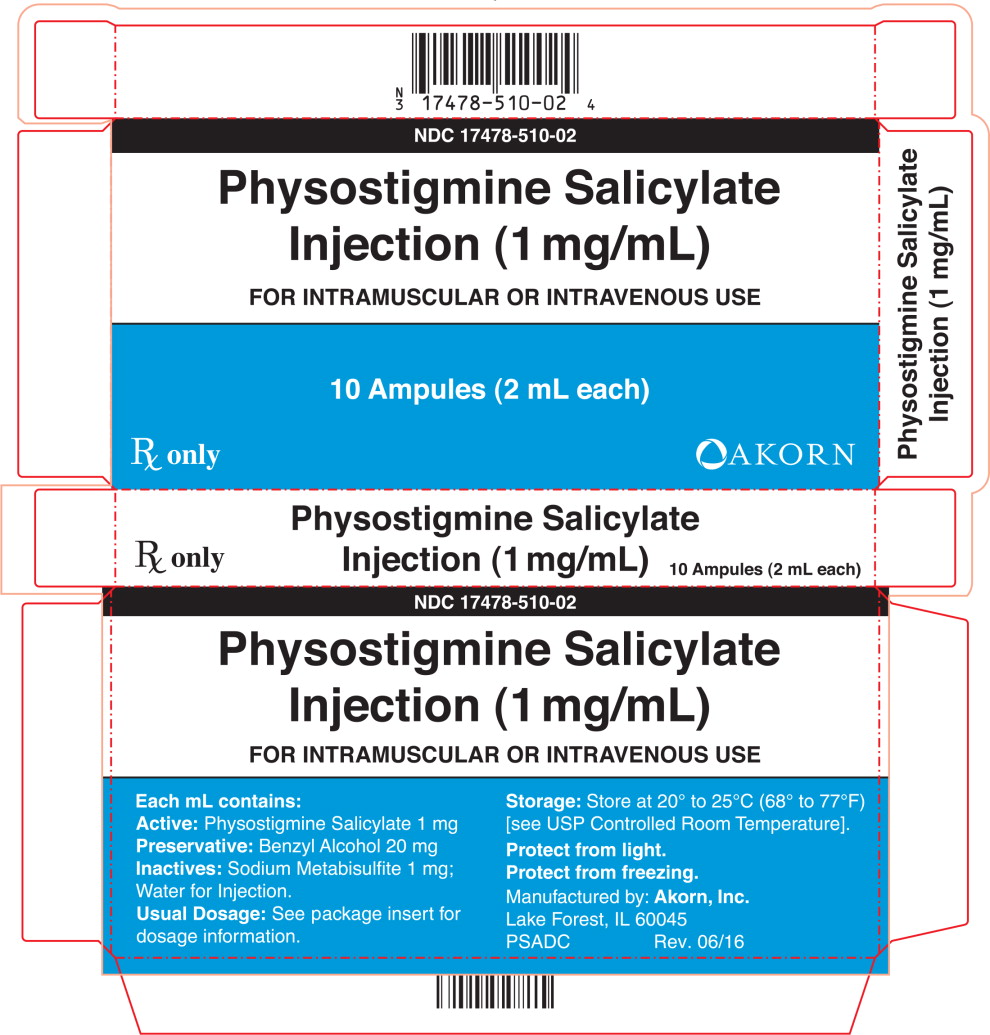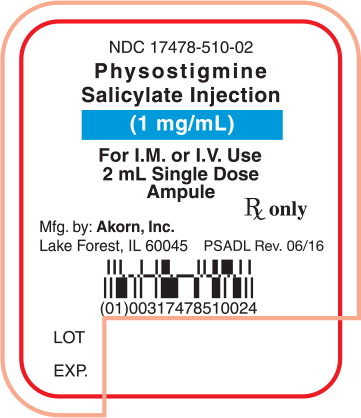PHYSOSTIGMINE SALICYLATE injection
Physostigmine Salicylate by
Drug Labeling and Warnings
Physostigmine Salicylate by is a Prescription medication manufactured, distributed, or labeled by Akorn. Drug facts, warnings, and ingredients follow.
Drug Details [pdf]
- SPL UNCLASSIFIED SECTION
-
DESCRIPTION:
Physostigmine Salicylate Injection is a derivative of the Calabar bean, and its active moiety, physostigmine, is also known as eserine. Its chemical structure is:
It is soluble in water and a 0.5% aqueous solution has a pH of 5.8.
Physostigmine Salicylate Injection is available in 2 mL ampules, each mL containing 1 mg of Physostigmine Salicylate in a vehicle composed of sodium metabisulfite 0.1%, benzyl alcohol 2.0% as a preservative in Water for Injection.
-
CLINICAL PHARMACOLOGY:
Physostigmine Salicylate Injection is a reversible anticholinesterase which effectively increases the concentration of acetylcholine at the sites of cholinergic transmission. The action of acetylcholine is normally very transient because of its hydrolysis by the enzyme, acetylcholinesterase. Physostigmine Salicylate Injection inhibits the destructive action of acetylcholinesterase and thereby prolongs and exaggerates the effect of the acetylcholine.
Physostigmine Salicylate Injection contains a tertiary amine and easily penetrates the blood brain barrier, while an anticholinesterase, such as neostigmine, which has a quaternary ammonium ion is not capable of crossing the barrier. Physostigmine Salicylate Injection can reverse both central and peripheral anticholinergia. The anticholinergic syndrome has both central and peripheral signs and symptoms. Central toxic effects include anxiety, delirium, disorientation, hallucinations, hyperactivity and seizures. Severe poisoning may produce coma, medullary paralysis and death. Peripheral toxicity is characterized by tachycardia, hyperpyrexia, mydriasis, vasodilation, urinary retention, diminution of gastrointestinal motility, decrease of secretion in salivary and sweat glands, and loss of secretions in the pharynx, bronchi, and nasal passages.
Dramatic reversal of the effects of anticholinergic symptoms can be expected in minutes after the intravenous administration of Physostigmine Salicylate Injection, if the diagnosis is correct and the patient has not suffered anoxia or other insult. The duration of action of Physostigmine Salicylate Injection is relatively short, approximately 45 to 60 minutes.
Numerous drugs and some plants produce the anticholinergic syndrome either directly or as a side effect; this undesirable or potentially dangerous phenomenon may be brought about by either therapeutic doses or overdoses of the drugs. Such drugs include among others, atropine, other derivatives of the belladonna alkaloids, tricyclic antidepressants, phenothiazines, and antihistamines.
- INDICATIONS AND USAGE:
-
CONTRAINDICATIONS:
Physostigmine Salicylate Injection should not be used in the presence of asthma, gangrene, diabetes, cardiovascular disease, mechanical obstruction of the intestine or urogenital tract or any vagotonic state, and in patients receiving choline esters and depolarizing neuromuscular blocking agents (decamethonium, succinylcholine).
For post-anesthesia, the concomitant use of atropine with physostigmine salicylate is not recommended, since the atropine antagonizes the action of physostigmine.
-
WARNINGS:
Contains sodium bisulfite, a sulfite that may cause allergic-type reactions including anaphylactic symptoms and life-threatening or less severe asthmatic episodes in certain susceptible people. The overall prevalence of sulfite sensitivity in the general population is unknown and probably low. Sulfite sensitivity is seen more frequently in asthmatic than in non-asthmatic people.
If excessive symptoms of salivation, emesis, urination and defecation occur, the use of Physostigmine Salicylate Injection should be terminated. If excessive sweating or nausea occur, the dosage should be reduced.
Intravenous administration should be at a slow, controlled rate, no more than 1 mg per minute (see dosage). Rapid administration can cause bradycardia, hypersalivation leading to a respiratory difficulties and possible convulsions.
An overdosage of Physostigmine Salicylate Injection can cause a cholinergic crisis.
- PRECAUTIONS:
- USAGE IN PREGNANCY:
-
ADVERSE REACTIONS:
Nausea, vomiting and salivation; can be offset by reducing dosage. Bradycardia and convulsions, if intravenous administration is too rapid. See DOSAGE AND ADMINISTRATION.
- OVERDOSAGE:
- DOSAGE AND ADMINISTRATION:
- OVERDOSAGE OF DRUGS THAT CAUSE ANTICHOLINERGIC:
-
PEDIATRIC DOSAGE:
Recommended dosage is 0.02 mg/kg; intramuscularly or by slow intravenous injection, no more than 0.5 mg per minute. If the toxic effects persist, and there is no sign of cholinergic effects, the dosage may be repeated at 5 to 10 minute intervals until a therapeutic effect is obtained or a maximum of 2 mg dosage is attained.
IN ALL CASES OF POISONING, THE USUAL SUPPORTIVE MEASURES SHOULD BE UNDERTAKEN.
-
HOW SUPPLIED:
NDC: 17478-510-02
2 mL Ampules packed 10 per box, 1 mg per mL.STORAGE: Store at 20° to 25°C (68° to 77°F) [see USP Controlled Room Temperature].
SOME DRUGS WHICH PRODUCE THE ANTICHOLINERGIC SYNDROME
Amitriptyline, Amoxapine, Anisotropine, Atropine, Benztropine, Biperiden, Carbinoxamine, Clidinium, Cyclobenzaprine, Desipramine, Doxepin, Homatropine, Hyoscine, Hyoscyamine, Hyoscyamus, Imipramine, Lorazepam, Maprotiline, Mepenzolate, Nortriptyline, Propantheline, Protriptyline, Scopolamine, Trimipramine.
SOME PLANTS THAT PRODUCE THE ANTICHOLINERGIC SYNDROME
Black Henbane, Deadly Night Shade, Devil's Apple, Jimson Weed, Loco Seeds or Weeds, Matrimony Vine, Night Blooming Jessamine, Stinkweed.
Akorn
Manufactured by: Akorn, Inc.
Lake Forest, IL 60045PS00N
Rev. 06/16 -
Principal Display Panel Text for Carton Label:
NDC: 17478-501-02
Physostigmine Salicylate
Injection (1 mg/mL)
FOR INTRAMUSCULAR OR INTRAVENOUS USE
10 Ampules (2 mL each)
Rx only Akorn logo
-
Principal Display Panel Text for Container Label:
NDC: 17478-510-02
Physostigmine
Salicylate Injection
(1 mg/mL)
For I.M or I.V. Use
2 mL Single Dose Ampule
Rx only
Mfg. by. Akorn, Inc. PSADL Rev. 11/08
-
INGREDIENTS AND APPEARANCE
PHYSOSTIGMINE SALICYLATE
physostigmine salicylate injectionProduct Information Product Type HUMAN PRESCRIPTION DRUG Item Code (Source) NDC: 17478-510 Route of Administration INTRAVENOUS Active Ingredient/Active Moiety Ingredient Name Basis of Strength Strength physostigmine salicylate (UNII: 2046ZRO9VU) (physostigmine - UNII:9U1VM840SP) physostigmine salicylate 1 mg in 1 mL Inactive Ingredients Ingredient Name Strength sodium metabisulfite (UNII: 4VON5FNS3C) benzyl alcohol (UNII: LKG8494WBH) water (UNII: 059QF0KO0R) Packaging # Item Code Package Description Marketing Start Date Marketing End Date 1 NDC: 17478-510-02 10 in 1 CARTON 08/10/2010 1 2 mL in 1 AMPULE; Type 0: Not a Combination Product Marketing Information Marketing Category Application Number or Monograph Citation Marketing Start Date Marketing End Date unapproved drug other 08/10/2010 Labeler - Akorn (062649876) Establishment Name Address ID/FEI Business Operations Akorn, Inc 155135783 MANUFACTURE(17478-510) , REPACK(17478-510) , ANALYSIS(17478-510)
© 2025 FDA.report
This site is not affiliated with or endorsed by the FDA.


